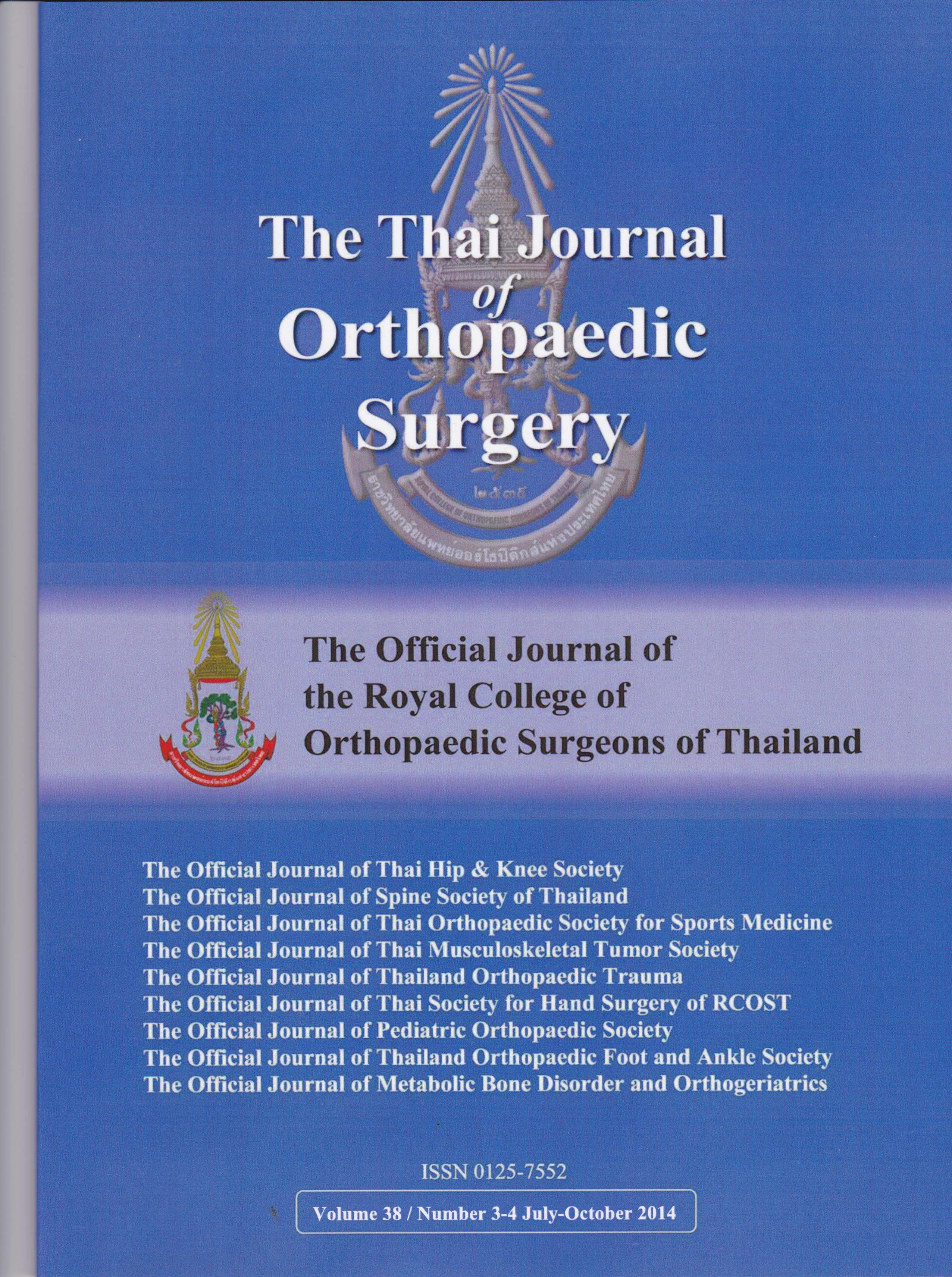Long-term Results of Carpal Tunnel Release Using Agee’s Single Portal Endoscopic Technique
Main Article Content
Abstract
Purpose: Open carpal tunnel release (OCTR) is the standard treatment after failed conservative management for carpal tunnel syndrome. Endoscopic carpal tunnel release (ECTR) has been developed and has been used increasingly over the last few years. According to several studies, ECTR results in a more rapid return to work and less scar tenderness than OCTR. Most studies have had short-term follow-ups and it is important to assess its long-term results. This study presents long-term results of ECTR by using a standard questionnaire.
Methods: There were 76 patients (94 hands) who underwent endoscopic carpal tunnel release (ECTR), using Agee’s single portal technique since July 1992 till October 1994. The Boston questionnaire was used to evaluate the long term results and patient satisfaction of this procedure, 28 patients (36 hands) responded with a mean age of 55 years at the time of operation and the mean follow-up period was 120 months. No complications developed in any patient. The Boston questionnaire is a self-administered questionnaire for the assessment of the severity of symptoms and functional status in patients who have carpal tunnel syndrome. There are 11 questions for symptom severity scoring, and 8 questions for functional severity scoring. The score varies from 1 (no problem) to 5 (very severe problem). The mean scores and standard deviations for symptom severity and functional status scores were recorded and classified into a range, with a score of 1-2 representing satisfactory, 2-3 as acceptable, 3-4 as fair, and 4-5 as unacceptable.
Results: Mean symptom severity scores were 1.41 and mean functional status scores were 1.32 . 96.43 % had no scar discomfort, and only 3.57 % had mild symptoms. All patients were satisfied with the results of the operation.
Conclusion: The subjective assessment of the long-term results of ECTR in our patients, using the Boston questionnaire was rated as satisfactory, and the results were comparable, if not better, than prior studies, which used the same questionnaire to assess conventional open carpal tunnel release.
Article Details
References
2. Phalen GS. The carpal tunnel syndrome. Seventeen years’ experience in diagnosis andtreatment of 654 hands. J Bone Joint Surg 1966; 48: 211-28.
3. Langloh ND, Linscheid RL. Recurrent and unrelieved carpal tunnel syndrome. Clin Orthop 1972; 83: 41-7.
4. MacDonald RI, Lichman DM, Hanlon JJ, Wilson JN. Complications of surgical release for carpal tunnel syndrome. J Hand Surg 1978; 3: 70-6.
5. Louis DS, Greene TL, Noellert RC. Complications of carpal tunnel surgery. J Neurosurg 1985; 62: 352-6.
6. Agee JM, Mc Carrol HR, Tortosa RD, Berry DA, Szabo RM, Peimer CA. Endoscopic release of the carpal tunnel: a randomized prospective multicenter study. J Hand Surg 1992; 17A: 987-95.
7. Brown RA, Gelbermann RH, Seiler JG, et al. Carpal tunnel release: a prospective randomized assessment of open and endoscopic methods. J Bone Joint Surg 1993; 75A: 1265-75.
8. Murphy RX, Jennings JF, Wukich DK. Major neurovascular complications of endoscopic carpal tunnel release. J Hand Surg 1994; 19A: 114-8.
9. Rowland EB, Kleinert JM. Endoscopic carpal tunnel release in cadavers: an investigation of the results of twelve surgeons with this training model. J Bone Joint Surg 1994; 76: 266-8.
10. Bozentka DJ, Osterman AL. Complications of endoscopic carpal tunnel release. Hand Clinic 1995; 11: 91-5.
11. Van Heest A, Waters P, Simmons B, Schwartz JT. A cadaveric study of the single-portal endoscopic carpal tunnel release. J Hand Surg 1995; 20A: 363-6.
12. Donald H Lee, Victiria R Masear, Richard D Meyer, et al. Endoscopic carpal tunnel release: a cardaveric study. J Hand Surg 1992; 17A: 1003-8.
13. Erhard L, Ozalip T, Citron N, Foucher G. Carpal tunnel release by the Agee endoscopic technique: results at 4 year follow-up. J Hand Surg 1999; 24B: 583-5.
14. Chow J, Hantes M. Endoscopic carpal tunnel release: thirteen years’ experience with the Chow technique. J Hand Surg 2002; 27A: 1011-8
15. Levine DW, Simmons BP, Koris MJ, et al. A self-administered questionnaire for the assessment of severity of symptoms and functional status in carpal tunnel syndrome. J Bone Joint Surg 1993; 75A: 1585-92.
16. Katz JN, Fossel KK, Simmons BP, et al. Symptoms, functional status, and neuromuscular impairment following carpal tunnel release. J Hand Surg 1995; 20A: 549-55.
17. Bradley MP, Hayes EP, Weiss APC, et al. A prospective study of outcomefollowing mini-open carpal tunnel release. Hand Surg 2003; 8: 59-63.
18. Nancollas MP, Peimer CA, Wheeler DR, Sherwin FS. Long-term results of carpal tunnel release. J Hand Surg 1995; 20B: 470-4.
19. Reale F, Ginanneschi F, Sicurelli F, Mondelli M. Protocal of outcome evaluation for surgical release of carpal tunnel syndrome. Neurosurgery 2003; 5: 343-50.
20. Modelli M, Ginanneschi F, Rossi S, Reale F, Padua L, Giannini F. Intra-observer reproducibility and responsiveness of a clinical severity scale in surgically treated carpal tunnel syndrome. Acta Neurol Scand 2002; 106: 263-8.
21. Heybeli N, Kutluhan S, Demirci S, Kerman M, Mumcu EF. Assessment of outcome of carpal tunnel syndrome: a comparison of electrophysiological findings and a self-administered Boston questionnaire. J Hand Surg 2002; 27B: 259-64.
22. Mondelli M, Reale F, Sicurelli F, Padua L. Relationship between the self-administered Boston questionnaire and electrophysiological findings in follow-up of surgically-treated carpal tunnel syndrome. J Hand Surg 2000; 25B: 128-34.

